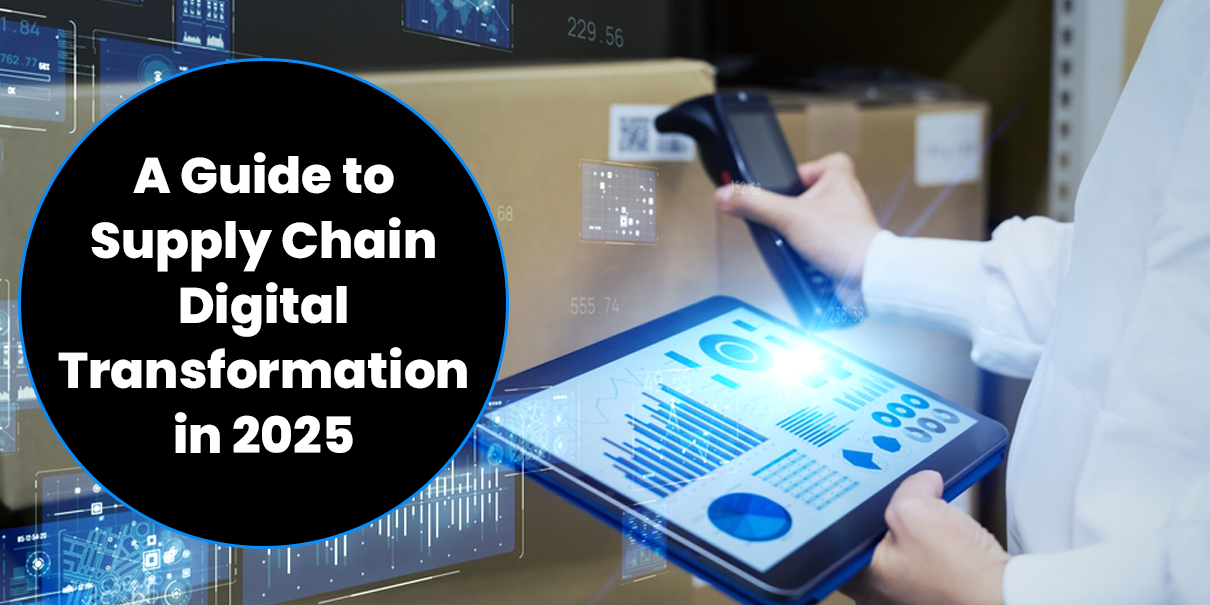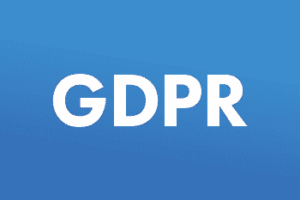Consumer goods shortages during the COVID pandemic highlighted the importance of supply chains – both domestic and international – and exposed an urgent need for modernization. Digital Transformation is one of the primary ways many companies choose to modernize, as the implementation of AI and machine learning-powered software offers countless benefits to any data-driven industry.
Supply chain Digital Transformation is the key to improving transport, logistics and warehouse operations to reduce overhead and improve efficiency through every link in the supply chain. In this guide, we will discuss the following:
- Top supply chain digital transformation goals
- AI and ML use cases for meeting those goals
- The best Digital Transformation implementation strategy
Let’s examine each topic more closely to better understand how logistics industry leaders can best adapt to the age of information.
Top Supply Chain Digital Transformation Goals
The supply chain relies heavily on data. This includes timetables for shipments, cargo manifests, accounts payable and receivable, and much more. As a result, many of the goals stated by logistics clients we have worked with center around the automation of data processes to make them more accurate, cost-effective, and auditable.
The table below lists the top priorities of 7T clients who contribute to both domestic and international supply chains.
| Goal | Details |
|---|---|
| Data Entry Automation | Many companies seek to reduce labor costs and improve the accuracy and speed of data entry processes by using AI and ML tools to automate data capture from scanned documents. |
| Compliance Automation | Transport companies, especially those that operate internationally, leverage AI tools to automate regulation compliance as cargo moves to ensure that compliance structures adapt to the varied regulations at every checkpoint. |
| Improved Supply Chain Traceability | One of the most important assets for supply chains is the ability to track inventory as it leaves its origin point, travels along its route, and arrives at its destination. |
| Document Generation | Automated document generation can accelerate loading and unloading processes by reducing the administrative workload required to ship goods. |
| Contract Management | Many firms value the ability to automate contract management processes to ensure they are charged accurately and that their agreements are always met with compliance. |
| Omnichannel Business Processes | Digital transformation allows businesses to operate across multiple channels and desktop and mobile app integration allows workers to integrate business processes if they are provided access to a work phone or a computer. |
Our clients prioritize these particular goals because they often have a direct impact on the bottom line and the flexibility and resilience of operations. Reducing administrative workflows leaves them less vulnerable to seasonality, and omnichannel operation improves their ability to operate with the wide variety of tech hardware available to workers in offices, warehouses, or vehicles. This reduces overhead, improves cargo loading and unloading times, improves the traceability of inventory as it travels along the supply chain, and makes it easy to audit every step of the process.
AI and ML Supply Chain Use Cases
Several different use cases for AI and machine learning technology can help companies throughout the supply chain meet the goals laid out above. To properly implement a Digital Transformation plan, firms must understand exactly how new technology will practically apply to their business.
The table below offers examples of common AI and ML use cases along the supply chain.
| Use | Description |
|---|---|
| AI Data Capture Tools | AI data platforms offer automated data entry, organization, and report generation. These tools make data capture faster, more accurate, and more cost-effective. |
| Inventory Tracing Tools | AI and ML help simplify tracking as inventory passes through the supply chain by automatically checking data from multiple warehouses and shipping manifests to provide real-time insight into inventory locations. They can also use historical data to determine more accurate arrival times. |
| Compliance Automation Tools | After entering regulatory information from relevant localities into machine learning-powered tools, they can connect with tracking solutions to ensure transporters have access to all the required information and paperwork without the need to request it or fill it out manually. |
| AP, AR, and Contract Generation | Automatically generates the necessary contracts and documents for accounts payable and receivable departments. |
| Omnichannel Applications | Modern software apps can be created to integrate business processes across multiple channels and end-user devices, including computer hardware, smartphones, computers, and tablets. |
While this isn’t an exhaustive list of AI’s use cases within the logistics industry, as AI and ML grow in capability with each passing day, it does offer examples of some of the most common applications deployed by our clients that contribute to the supply chain. Many of these use cases are implemented together within an all-in-one platform, so long as businesses choose a Digital Transformation partner capable of leveraging the best possible technology.
The Best Digital Transformation Implementation Strategy
Typically, choosing the best Digital Transformation implementation strategy means evaluating all available software providers, developers, or consultants that specialize in the type of tool you need.
There are a few different ways to get this done:
- In-House Development
Hire in-house staff to develop, maintain, and train staff on a new software solution. - Third-Party Out-of-the-Box Software.
Buy multiple out-of-the-box software tools to transform different aspects of the business and rely on a few different providers for software and training materials. - Third-Party Custom Software.
Hire a custom software developer to assess your needs, create bespoke software tailored to your processes/goals, and provide training materials for your staff.
We recommend the Custom Developer Strategy, because it provides custom solutions, top talent and full support.
In-House Development
| Pros | Cons |
|---|---|
| ✔ Custom-tailored solutions | ✘ Most expensive option |
| ✔ In-house staff training resources | ✘ Limited talent |
| ✔ Ongoing maintenance | ✘ Long hiring process |
Hiring in-house developers to architect your Digital Transformation typically ensures that your needs are met because your own staff will be creating the tools. It also makes it easier to train users since the team that created the software is always there to lend a helping hand and respond to support tickets.
Hiring full-time staff is usually the most expensive Digital Transformation strategy because there is no economy of scale from which to benefit. The level of development talent can also be an issue. Your firm’s ability to vet highly specialized experts is the limiting factor for the talent you can acquire – unless you hire recruiters, which will make this method even more expensive.
You’ll also be competing in an extremely tight job market against dedicated software companies that frequently provide more support and upward mobility for developers, which is what the most talented candidates often value.
Third-Party Out-of-the-Box Software
| Pros | Cons |
|---|---|
| ✔ Cheap | ✘ Generic and limited feature sets |
| ✔ Easy to train staff | ✘ Have to accommodate multiple timelines |
| ✔ Relatively bug-free | ✘ Expensive to add features |
The least expensive option on the list is to purchase multiple out-of-the-box software tools, but remember: you get what you pay for. However, these tools do have select advantages. They’re marketed to multiple companies, so they’re relatively bug-free and have dedicated bug-fixing teams, in addition to comprehensive libraries of user training content.
Beyond these benefits, however, these tools can be troublesome. For firms looking to meet multiple goals, it can be frustrating to deal with multiple service providers with varying timelines and processes.
In general, these tools are not custom-tailored to your goals, and many businesses find themselves getting nickel-and-dimed for “extra” features to get an end product that is truly valuable to them. As a result, we can really only recommend this option for firms with a single, simple goal, like adding chatbot functionality to a website, easier payment processing on a shop page, or other similar use cases.
Third-Party Custom Software
| Pros | Cons |
|---|---|
| ✔ Custom-tailored solutions | ✘ More expensive than OOTB software devs |
| ✔ Top-tier development talent | ✘ Development staff aren’t in-house |
| ✔ Accessible training and support | |
| ✔ Full onboarding assistance |
Hiring a custom software developer is the option that delivers maximum value by combining the convenience of in-house staff with the benefits of hiring third-party developers. A quality custom dev will do a deep dive into your business and its processes to understand your exact pain points and Digital Transformation opportunities.
An expert dev team will work with your company to create and deploy premium software with cutting-edge technology. You can usually expect them to staff exceptional talent since they specialize in creating purpose-driven tools for niche industries, and they are generally more available for staff training and user support since they frequently introduce new tools to businesses of all sizes.
The drawbacks include a higher price tag than OOTB software, and you don’t get the benefit of having your developers in-house. High-quality custom developers like 7T work to alleviate these cons by providing quick and comprehensive support, along with enough value to ensure your Digital Transformation always generates more than enough income to negate the cost.
Implement Supply Chain Digital Transformation With 7T
At 7T, we use a problem → solution approach to create AI/ML solutions for our clients across countless supply chain-related industries. Through our custom-built platforms, machine learning and AI technology can provide significant operational advantages with a robust ROI. Our team will audit your organization’s challenges, often by showing up on-location for a time to embed ourselves within your business and understand your needs from a first-person perspective. Then, we’ll architect a value-generating solution to transform your vital processes and meet your goals.
7T is based in Dallas, Houston and Charlotte, NC, but our clientele spans the globe. If you’re ready to learn more about supply chain digital transformation, contact 7T today.









